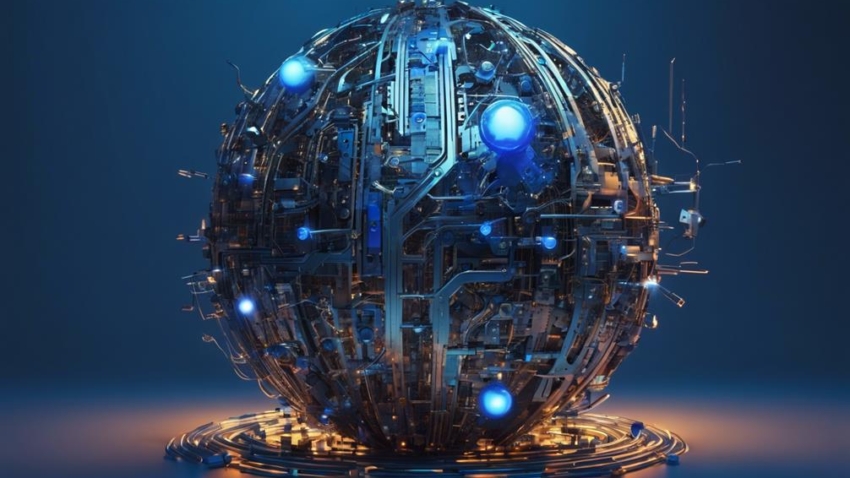
Redefining Industry Standards Through Technology
Technology is redefining industry standards by driving unprecedented levels of efficiency, agility, and innovation. In supply chain management, digital solutions enhance visibility, transparency, and control, while AI-driven predictive maintenance minimizes downtime and reduces maintenance costs. Blockchain technology guarantees robust data security, and IoT devices automate industrial processes. Cybersecurity measures safeguard against threats, and data analytics informs decision-making. Embracing digital transformation, industries are leveraging cloud-based technologies and harnessing the power of data analytics. As technology continues to advance, industries will experience even more transformative shifts – and the most forward-thinking organizations will be those that stay ahead of the curve.
Revolutionizing Supply Chain Management
In today's fast-paced digital landscape, a significant 75% of companies have implemented digital supply chain management solutions to streamline operations, reduce costs, and enhance customer satisfaction. This pivotal shift is driven by the need for greater control, transparency, and agility in managing complex global supply chains.
Supply Chain Visibility is a vital aspect of this digital transformation, enabling organizations to track shipments, monitor inventory levels, and respond to disruptions in real-time. With end-to-end visibility, companies can pinpoint bottlenecks, optimize logistics, and make data-driven decisions to minimize risks and maximize efficiency.
Inventory Optimization is another critical component of digital supply chain management, allowing businesses to accurately forecast demand, manage stock levels, and reduce waste. By leveraging advanced analytics and machine learning algorithms, companies can fine-tune their inventory strategies, minimize stockouts and overstocking, and free up working capital.
AI-Driven Predictive Maintenance
The implementation of AI-driven predictive maintenance is transforming the industry's approach to equipment upkeep. By leveraging machine learning algorithms, organizations can detect potential faults in real-time, enabling proactive maintenance and minimizing downtime. This proactive approach not only reduces costs but also enhances overall operational efficiency and reliability.
Machine Learning Algorithms
Eighty percent of unplanned downtime can be attributed to equipment failure, emphasizing the critical need for proactive maintenance strategies, which is where machine learning algorithms come into play. By leveraging machine learning algorithms, industries can shift from reactive to proactive maintenance, minimizing downtime and maximizing productivity.
Machine learning algorithms enable the detection of anomalies and prediction of equipment failures, allowing for timely interventions and reducing the likelihood of unplanned downtime. Some key applications of machine learning algorithms in predictive maintenance include:
- Anomaly Detection: Identifying unusual patterns in equipment behavior to prevent unexpected failures
- Model Explainability: Providing transparency into model decision-making processes to build trust and accountability
- Predictive Modeling: Forecasting equipment failure probability to schedule maintenance and minimize downtime
- Root Cause Analysis: Identifying underlying causes of equipment failures to inform proactive maintenance strategies
- Real-time Monitoring: Continuously monitoring equipment performance to detect early signs of failure
Real-time Fault Detection
By leveraging machine learning algorithms to detect anomalies and predict equipment failures, industries can take the next step towards real-time fault detection, where AI-driven predictive maintenance enables immediate response to emerging issues. This proactive approach allows for swift intervention, minimizing downtime and reducing maintenance costs. Real-time fault detection enables industries to move beyond reactive maintenance and adopt a proactive stance, ensuring peak machine conditions and minimizing the risk of unexpected failures.
| Failure Modes | Detection Methods |
|---|---|
| Overheating | Temperature sensors, thermal imaging |
| Vibration | Accelerometers, vibration analysis |
| Electrical Faults | Voltage monitoring, current analysis |
| Mechanical Failure | Acoustic emission testing, ultrasonic testing |
Blockchain for Secure Data
The integration of blockchain technology offers a robust solution for securing data, leveraging advanced encryption methods to safeguard sensitive information. Decentralized storage solutions, enabled by blockchain, provide an additional layer of security, making it increasingly difficult for unauthorized parties to access or manipulate data. By exploring these innovative approaches, industries can establish a new standard for data security and integrity.
Data Encryption Methods
In today's digital landscape, where data breaches and cyber-attacks have become increasingly prevalent, the need for robust data encryption methods has never been more pressing, particularly with the advent of blockchain technology. As data continues to grow in value and importance, organizations must prioritize the security of their data to maintain trust and credibility with their customers.
To achieve this, various data encryption methods can be employed, including:
- Quantum Cryptography: leveraging the principles of quantum mechanics to create unbreakable encryption keys
- Homomorphic Encryption: enabling computations to be performed on encrypted data, ensuring data remains secure even during processing
- Multi-Party Computation: allowing multiple parties to jointly perform computations on private data without revealing their individual inputs
- Secure Multi-Party Computation: enabling secure computation on private data without compromising individual inputs
- Fully Homomorphic Encryption: enabling arbitrary computations on encrypted data without decryption
Decentralized Storage Solutions
Decentralized storage solutions, underpinned by blockchain technology, offer a paradigm shift in secure data management, enabling individuals and organizations to reclaim control over their sensitive information. By leveraging blockchain's immutable and transparent nature, decentralized storage solutions provide a secure and reliable means of storing and managing data. This approach eliminates the need for centralized intermediaries, allowing users to maintain autonomy over their data. Cloud archiving, a traditional method of data storage, is limited by its reliance on centralized infrastructure, making it vulnerable to data breaches and manipulation. In contrast, decentralized storage solutions utilize edge computing to process and store data at the edge of the network, reducing latency and improving security. This decentralized approach enables real-time data processing, making it ideal for applications that require low-latency and high-security data management. By adopting decentralized storage solutions, individuals and organizations can regain control over their data, ensuring the integrity and confidentiality of their sensitive information.
IoT in Industrial Automation
Nearly 70% of industrial organizations have implemented or are planning to implement IoT technologies to drive efficiency and productivity in their automation processes. This widespread adoption is largely driven by the need for real-time monitoring, predictive maintenance, and optimized resource allocation. IoT in industrial automation enables organizations to gain deeper insights into their operations, make data-driven decisions, and improve overall performance.
Some key benefits of IoT in industrial automation include:
- Improved equipment reliability: IoT-enabled industrial sensors provide real-time monitoring and anomaly detection, allowing for swift identification and resolution of potential issues.
- Enhanced device interoperability: IoT facilitates seamless communication between devices from different manufacturers, ensuring harmonious operation and minimizing downtime.
- Predictive maintenance: IoT-enabled sensors can detect potential equipment failures, enabling proactive maintenance and minimizing costly downtime.
- Optimized resource allocation: IoT provides real-time data on resource utilization, enabling organizations to optimize resource allocation and reduce waste.
- Enhanced supply chain management: IoT enables real-time tracking and monitoring of products throughout the supply chain, improving logistics and reducing costs.
The Future of Customer Service
As customer expectations continue to evolve, the fusion of human empathy and artificial intelligence is positioned to revolutionize the customer service landscape. The future of customer service lies in harnessing the power of technology to create personalized experiences that cater to individual needs and emotions. Personalization strategies, fueled by data analytics and machine learning, will enable businesses to tailor their services to meet the unique preferences and behaviors of each customer.
Emotional intelligence will play a pivotal role in this new era of customer service, as AI-powered systems learn to recognize and respond to emotional cues, empathizing with customers on a deeper level. Chatbots, for instance, will evolve to become empathetic conversationalists, capable of detecting and responding to emotional nuances in customer interactions. This fusion of human empathy and AI-driven insights will empower businesses to deliver proactive, anticipatory service that exceeds customer expectations.
As customers increasingly demand seamless, omnichannel experiences, businesses must adapt to deliver personalized, emotionally intelligent service across all touchpoints. By integrating AI-driven insights with human emotional intelligence, businesses can create a new standard of customer service that is both efficient and empathetic. The future of customer service is not about replacing humans with machines, but about leveraging technology to augment human capabilities, creating a harmonious blend of technology and empathy that redefines the customer experience.
Streamlining Operations With RPA
By harnessing the power of automation, businesses can radically transform their operational efficiency, freeing up resources to focus on high-value tasks that drive innovation and customer-centricity. Robotic Process Automation (RPA) is a key technology enabling this transformation, allowing organizations to streamline their operations and achieve unprecedented levels of productivity.
With RPA, businesses can automate repetitive, rule-based tasks, reducing the likelihood of human error and increasing process efficiency. This, in turn, enables employees to focus on higher-value tasks that require creativity, empathy, and problem-solving skills. By automating mundane tasks, organizations can:
- Optimize process automation: Automate routine tasks, freeing up staff to focus on strategic initiatives
- Improve task prioritization: Allocate resources to high-priority tasks, ensuring timely completion of critical projects
- Enhance data accuracy: Reduce errors and inconsistencies, ensuring data integrity and compliance
- Boost productivity: Increase throughput and efficiency, reducing costs and improving customer satisfaction
- Gain real-time insights: Access to timely, accurate data enables data-driven decision-making and improved operational visibility
Cybersecurity in the Digital Age
As the digital landscape continues to evolve, the threat of cyber attacks has become an increasingly pressing concern for organizations across industries. The digital threat landscape is constantly shifting, with new attack vectors emerging and evolving at an alarming rate. In this precarious environment, it is essential to examine the complexities of the digital threat landscape and the various cyber attack vectors that pose a significant risk to modern businesses.
Digital Threat Landscape
The rapid proliferation of interconnected devices and systems has created an expansive attack surface, dramatically escalating the digital threat landscape in the digital age. As the number of connected devices continues to grow, organizations face an unprecedented level of risk. It is imperative to acknowledge that cyber hygiene is no longer a choice, but a necessity.
To mitigate the risks, organizations must prioritize their cybersecurity posture. Here are key considerations to address the evolving digital threat landscape:
- Implement robust identity and access management systems to restrict unauthorized access
- Conduct regular security audits to identify vulnerabilities in the attack surface
- Establish a culture of cyber hygiene, educating employees on best practices and protocols
- Invest in advanced threat detection and response capabilities to stay ahead of emerging threats
- Develop incident response plans to minimize downtime and data loss in the event of a breach
Cyber Attack Vectors
Sophisticated cyber attack vectors have emerged as a formidable force, leveraging the complexities of interconnected systems to infiltrate even the most seemingly impenetrable defenses. These vectors exploit vulnerabilities in network infrastructure, allowing attackers to gain unauthorized access and compromise sensitive data. Network exploitation is a critical concern, as a single breach can have far-reaching consequences.
Attackers often employ tactics that manipulate human psychology, using social engineering techniques to deceive individuals into divulging sensitive information or clicking on malicious links. Phishing, pretexting, and baiting are just a few examples of the ways in which cybercriminals exploit human vulnerabilities to gain access to sensitive systems. To combat these threats, organizations must prioritize robust cybersecurity measures, including regular vulnerability assessments, penetration testing, and employee education programs. By understanding the tactics employed by cybercriminals, organizations can better prepare themselves to detect and respond to emerging threats, ultimately safeguarding their digital assets and maintaining control in an increasingly complex threat landscape.
Embracing Digital Transformation
In today's fast-paced business landscape, 70% of companies believe that digital transformation is essential for their survival, making it imperative for organizations to adapt to the changing technological landscape. As the world becomes increasingly digitized, embracing digital transformation is no longer a choice, but a necessity for businesses to stay competitive.
To successfully navigate this transformation, organizations must cultivate a Digital Culture that fosters innovation, collaboration, and continuous learning. This requires developing a workforce with Digital Literacy, where employees are equipped with the skills to leverage technology to drive business outcomes.
To achieve this, organizations can:
- Develop a clear digital vision and strategy
- Invest in employee training and development programs
- Foster a culture of innovation and experimentation
- Leverage cloud-based technologies to enhance agility and scalability
- Establish metrics to measure digital transformation progress
Data Analytics for Better Insights
Data-driven decision-making has become the cornerstone of successful businesses, as they rely on timely and accurate insights to stay ahead of the competition. In today's fast-paced digital landscape, organizations that fail to harness the power of data analytics risk being left behind. By tapping into the potential of data analytics, businesses can uncover hidden patterns, identify areas of improvement, and make informed decisions that drive growth.
To reveal the full potential of data analytics, businesses must invest in robust Business Intelligence tools that provide real-time insights and data visualization capabilities. Data Visualization, in particular, plays a critical role in helping organizations make sense of complex data sets, enabling stakeholders to quickly identify trends, opportunities, and challenges. By presenting complex data in a clear and concise manner, data visualization empowers decision-makers to take swift and informed actions.
Moreover, advanced data analytics enables organizations to move beyond mere reporting and into predictive and prescriptive analytics. This shift enables businesses to anticipate future outcomes, simulate scenarios, and optimize operations for maximum efficiency. By embracing data analytics, organizations can break free from the constraints of traditional decision-making and usher in a new era of agility, innovation, and competitiveness. As the digital landscape continues to evolve, one thing is clear: data analytics is no longer a luxury, but a necessity for businesses seeking to redefine industry standards.
Smarter Manufacturing With Industry 4.0
As the manufacturing landscape undergoes a profound transformation, the fusion of physical and digital systems is giving rise to a new era of smart manufacturing, where machines, products, and humans collaborate in unprecedented ways. Industry 4.0 is revolutionizing the way goods are produced, making it possible to create customized products with unprecedented efficiency and precision.
The key to this transformation lies in the integration of advanced technologies such as artificial intelligence, Internet of Things (IoT), and robotics. This convergence enables the creation of a Digital Workforce, where Factory Robots and machines can learn, adapt, and interact with humans in real-time.
Some of the key benefits of Industry 4.0 include:
- Increased Efficiency: Automation and machine learning enable faster production cycles and reduced downtime.
- Improved Quality: Advanced sensors and IoT devices ensure accurate monitoring and control of production processes.
- Enhanced Customization: Mass production of customized products becomes possible with the help of AI-powered design and production systems.
- Reduced Costs: Optimized production processes and minimized waste minimize costs and environmental impact.
- Enhanced Safety: Collaborative robots and advanced safety systems minimize the risk of accidents and injuries.
Frequently Asked Questions
How Do I Ensure a Seamless Transition to New Technology in My Organization?
To maximize the benefits of new technology, it's essential to prioritize change management and employee engagement. Develop a thorough strategy that addresses potential resistance to change, and foster open communication to alleviate concerns. Engage employees through training and feedback mechanisms, empowering them to take ownership of the shift. By doing so, you'll build trust, minimize disruption, and unleash the full potential of your new technology investment.
What Are the Potential Risks of Relying on Ai-Driven Decision-Making Systems?
'Flickering fluorescent lights cast a suspicious glow on the dark alleys of AI-driven decision-making systems. As we surrender to the allure of automation, we must acknowledge the perils of algorithmic bias, where machines mirror our own prejudices. To mitigate these risks, it is vital to maintain human oversight, ensuring that AI's cold calculations are tempered by human empathy and ethics, lest we sacrifice fairness on the altar of efficiency.'
Can Blockchain Be Used for Applications Beyond Supply Chain Management?
Beyond supply chain management, blockchain technology can be leveraged for a multitude of innovative applications. One promising area is digital identity verification, enabling secure and decentralized management of personal data. Additionally, blockchain can facilitate the development of smart cities, where it can optimize energy distribution, traffic management, and waste reduction. By harnessing blockchain's potential, cities can become more efficient, sustainable, and citizen-centric.
How Do I Measure the ROI of Investing in Industry 4.0 Technologies?
As the industrial revolution's steam engine roared to life, so too must your ROI calculations. When measuring the return on investment in Industry 4.0 technologies, a meticulous cost analysis is necessary. Key financial metrics, such as total cost of ownership, operational efficiency gains, and increased productivity, must be carefully considered. By examining these metrics, you'll gain a thorough understanding of your ROI, empowering data-driven decisions that drive business growth and profitability.
What Are the Most Critical Cybersecurity Threats Facing Industrial Organizations Today?
Industrial organizations face unprecedented cybersecurity threats, with ransomware attacks and phishing scams being among the most critical. Ransomware attacks, which encrypt critical data, can cripple operations and compromise sensitive information. Phishing scams, often disguised as legitimate emails, can deceive employees into divulging confidential information. These threats can have devastating consequences, including data breaches, financial losses, and reputational damage. It is essential for industrial organizations to prioritize robust cybersecurity measures to mitigate these risks and protect their assets.











